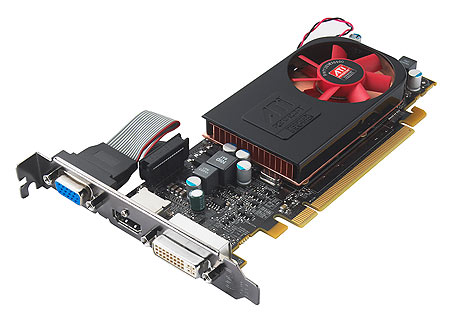ATI Radeon HD 5570: Reasonable Gaming Performance For $80?
Conclusion
What do you get when you mix DirectX 11, a trio of display outputs (though, bear in mind, the card on our test bench doesn't support three displays), bitstreaming, and a $10 price increase to the Radeon HD 4670? You get a Radeon HD 5570, more or less. This card is a tad faster than its predecessor, but performance is really quite similar.
This isn't necessarily a bad thing. Adding $10 to the Radeon HD 4670 for the extra features seems reasonable if you're coming from the world of integrated graphics. It's a less-attractive option if you're already running a discrete card and would need to sink another $80 into your next card for similar performance. In that case, you'd be much better served by a straight-up upgrade to something like the Radeon HD 5750 or 5770. Instead, the Radeon HD 5570 maintains the status quo when it comes to price/performance, and unfortunately isn't able to out-do the similarly-priced GeForce 9600 GT.
With the 5570's game performance so close to that of its predecessor, you're faced with the same conundrum we've seen with all of the other sub-$100 Radeon HD 5000-series cards thus far: do you want game performance or a bundle of value-adds? Are you willing to sacrifice detail settings and anti-aliasing in favor of Eyefinity and DirectX 11 support (which is of questionable utility on a mainstream GPU anyway)? Just as the buyer with $100 has to choose between the feature-rich Radeon HD 5670 and the fast Radeon HD 4850, enthusiasts with $80 have to decide whether they'd prefer the feature-rich Radeon HD 5570 or quicker GeForce 9600 GT.
Aside from raw gaming performance, it's important to acknowledge that the features being offered by ATI's Radeon HD 5570 are, in fact, compelling today. Consider that this is a half-height reference card, able to transform even the smallest systems into viable gaming machines. Power usage is extremely low for the performance offered, and no auxiliary power connector is needed. And yet, the Radeon HD 5570 manages playable frame rates in every one of our game tests at 1680x1050 (and sometimes 1920x1200). Triple-monitor Eyefinity gaming could be viable in less-demanding titles, such as World of Warcraft, at a price substantially lower than the Radeon HD 5670. Just make sure the board you buy has a DisplayPort output first.
All of these features make it easier to recommend the Radeon HD 5570 over the slightly less expensive (but notably slower) Radeon HD 5450.
Conversely, we can't deny the appeal of Nvidia's GeForce 9600 GT for the gamers sticking to optimal performance on a single display for $80.
We'll also point out that, in this crowded price segment, it's amazing how much difference a few dollars can make. The new Radeon HD 5670 can already be found for $95 online, representing a modest $5 drop from the MSRP within a month of its release. If the Radeon HD 5570 follows suit and distance itself from the GeForce 9600 GT by $5 or $10 more, then it becomes a more attractive buy. With AMD’s monopoly on DirectX 11 hardware for the time being (and near future, given the lack of detail on any mainstream refresh to Nvidia's lineup), this might not realistically happen until the competition can deliver an updated feature set.
Get Tom's Hardware's best news and in-depth reviews, straight to your inbox.
At this point, AMD's DirectX 11 portfolio is now complete, from top to bottom, $80 to $680. The only missing piece of the puzzle might be a Radeon HD 4650 counterpart in the 5000-series, though we've heard no mention of such a card. It's been a long journey, and just in case you've missed any of it, well, here you go:
Radeon HD 5970
Radeon HD 5870
Radeon HD 5850
Radeon HD 5770
Radeon HD 5750
Radeon HD 5670
Radeon HD 5570
Radeon HD 5450
That's quite a list; and to think that's just our launch coverage since September of last year...
Don Woligroski was a former senior hardware editor for Tom's Hardware. He has covered a wide range of PC hardware topics, including CPUs, GPUs, system building, and emerging technologies.

